In the late 1880’s and early 1890’s large groups of immigrants known as Rusyns, a Central European ethnic group hailing from the regions of Carpathia Rus (primarily in Slovakia) and neighboring Galicia (Ukraine and Poland), emigrated to the United States and primarily settled in Eastern Pennsylvania and the greater New York City area. They found work as coal miners or industrial workers in manufacturing plants and steel mills. By the early 1900’s the Rusyn immigrants began concentrating in Western Pennsylvania and Eastern Ohio, with Pittsburgh becoming the center of the Rusyn world in America.
The Rusyns never had a country of their own and came to the United States from an area that now encompasses regions of Slovakia, Poland, Ukraine, and Romania. They primarily resided in small, rural villages and made a meager living tending to small farms, tending to flocks of sheep, and working as loggers. There is some dispute on the origin and actual heritage of the Rusyns, often referred to as Carpatho-Rusyns or Ruthenians. They are often mixed in other closely associated people or monikers such as the Slavish, Ukrainians, Russians, or Slovaks, but make no mistake the Rusyns are a distinct ethnic group with their own customs, traditions, and language.
Historically, most Rusyns adhered to the Eastern Orthodox religion, but strong influences from neighboring countries and the Roman (or Latin) Catholic Church compelled them to realign with the Greek (or Eastern) Catholic Church in the 16th Century. Unlike the Roman Catholic Church, a lone entity, there were numerous Greek Catholic Churches which were organized along ethnic lines such as the Belarussian Greek Catholic Church, Russian Greek Catholic Church, Ukrainian Greek Catholic Church, and the Ruthenian (Rusyn) Greek Catholic Church.
These churches had been at odds with the Roman Catholic Church since a schism, concerning the authority of the Pope, dating back to the 11th Century. This was essentially a struggle between the East and the West – the Greek Catholics against the Roman Catholics. With their own unique liturgies, church-owned property, and married priests within the ranks, the Greek Catholic Church was often at odds with the Papal authority. Many branches of the Greek Catholic Church allowed their priests to be married prior to being ordained, while the mainstream Roman Catholic Church mandated that all its priests be unmarried and celibate.
The Greek Catholic immigrants, initially without a ruling hierarchy or jurisdiction of their own, fell under the direct – and often harsh – control of the American hierarchy of the Roman Catholic Church. Attempts to “latinize” them was met with resistance and led to some defections back to the Eastern Orthodox faith. Further measures divided the traditionalist-minded Greek Catholics, who were branded as inferior to Roman Catholics, along nationalistic lines and infighting ensued. The Rusyn community was generally in opposition to the Roman Catholic Church, but also was sharply divided among itself among Slovakian and Ukrainian factions.
In 1907 the Vatican appointed the Reverend Soter Ortynsky (1866-1916), from a region in Galicia now part of modern-day eastern Ukraine, as bishop of all Greek Catholics in the United States. Due to his Ukrainian heritage the Rusyns from the Slovakia region disapproved of him and this caused further strife. The state of the early Greek Catholics in the United States was one of intense strife. In 1916, after the untimely death of Bishop Ortynsky, the Vatican separated the Greek Catholics in the United States into Carpathian and Ukrainian orders each with its own “administrator.”
In the early 1900’s a small Rusyn community was established in New Castle, Pennsylvania, centered in the area of Oakland and neighboring areas on the West Side. Most of those who came to New Castle worked in the various mills and plants along the Shenango River. Without a church of their own they likely attended services at nearby churches such as the St. Mary’s or St. Joseph’s Catholic Church. A local branch of the fraternal organization known as the Greek Catholic Union of the Rusyn Brotherhoods was established, which provided insurance for Rusyn immigrants in addition to advocating politically for their causes.
In 1909 the small Rusyn community, along with others that were closely associated, began organizing to form a congregation that became known as the St. Nicholas Greek Catholic Church. It included Rusyns from both Slovakia and Ukraine and some Russians. The New Castle News of Thursday, December 23, 1909, mentioned, “It is probable that a Greek Catholic church will be established in New Castle in the near future. The men interested in the proposition have been inspecting the building owned by the Welsh congregation on South Mill and Reynolds streets with a view to purchasing it. At present the church is being used as a German-Hungarian mission under control of an up-town church.”
At that same time other churches for Central European immigrants were also being established. In 1909 a small group of immigrants adhering to the Eastern Orthodox Church, mostly hailing from the western reaches of the Russian Empire, began meeting on the South Side of New Castle. They mainly included people of Russian heritage, but also other nationalities to include Belarusian, Ukrainian, Lithuanian, Romanian, and Polish. In late 1910 they applied for charter for what they called the Holy Trinity Russian Greek Catholic Orthodox Church, but it was held up due to the use of the “Catholic” in the name. It was commonplace for Orthodox congregations to use the name Catholic, but the Roman Catholic officials fought this. The congregation, which erected a church on Moravia Street, became known as the Holy Trinity Russian Orthodox Church.
A Greek Catholic church for Polish immigrants, the Holy Trinity Polish Catholic Church, was also organized in the Sheep Hill area in 1913. After a bitter dispute with the Roman Catholic diocese in Pittsburgh, primarily over property ownership, the congregation dropped the word “Catholic” from its name and became an independent parish for a few years. Other Orthodox churches were established in New Castle and Ellwood City in the coming years.
Soon after its establishment the St. Nicholas congregation purchased a small frame church, built by the First Congregational Church, at the corner of South Mill and East Reynolds Streets. This church was originally dedicated by the Welsh congregation, many of whom worked in the thriving tin mills, on August 30, 1896. The local Welsh population quickly expanded and the church was outgrown almost immediately. A nearby lot on East Reynolds Street was soon purchased and a larger brick church was opened there in 1900. The old building, although up for sale, was initially used the new Grace Methodist Episcopal Church until they opened their own church nearby at Agnew and Reynolds Streets in July 1901. The old Welsh Church was then rented out for church gatherings, association meetings, and social events for the next decade. It was utilized as an annex during 1904-1905 for students in the overcrowded Fifth Ward until the new Home Street School was opened in October 1905.
The New Castle News of Saturday, February 12, 1910, reported, “A deal was consummated Friday whereby the old Welsh Congregational church property at South Mill and Reynolds street was disposed of to the Greek Catholic church. The consideration was in the neighborhood of $5,000. Since the erection of the new edifice on East Reynolds between Mill and Jefferson streets, the Welsh Congregation has had no use for the old property and some time ago decided to dispose of it.”
The new St. Nicholas congregation was initially served by visiting priests, until the Reverend John N. Danilovich (1881-1923), the pastor of the St. Michael’s Byzantine Catholic Church in nearby Farrell, began providing regular sermons at the church sometime in 1910. He likely served both churches until the Reverend Miron A. Volkay (1873-1923), previously serving a church in Pittston, Pennsylvania, took over as pastor of St. Nicholas in late 1917. At the time the Great War (World War I) was raging across Europe and, in addition to halting immigration, caused great strife for many Rusyns worried about what was transpiring back in the Old Country.
Volkay immediately helped launch a building program to make improvements to the small church. The old frame building, serving as the foundation, was encased in brick and a beautiful red brick rectory was connected at the rear. The rectory, at #205 East Reynolds Street, became the dedicated home of the pastor in years to come. The congregation spent about $26,000 on all the improvements.
An article in the New Castle News of Saturday, August 31, 1918, mentioned, “Formal dedication and laying of the cornerstone of St. Nicholas’ Greek Catholic church, corner of South Mill and Reynolds streets, will take place on Monday morning at 11 o’clock, in the presence of members of the congregation and interested people of the city, with all the beautiful rites and ceremonies of the Catholic church… The congregation of St. Nicholas Greek Catholic church is made up of some 160 families, representing a membership in excess of 700 people. Since Rev. Volkay has assumed charge here, the affairs of the congregation have been moving along in excellent order, owing to his efficient work, and the erection of the new church and parish house is an indication of the progress made.”
The article explains more about the remodeling effort with, “Three bells costing $2,000 have been ordered for the church tower and are expected to be here for the Monday morning service, but owing to freight shipping conditions, they may not arrive in time. A handsome new model altar and some fifty or sixty handsome oil paintings for the interior of the church have also been ordered and will be put in place in the church as soon as they arrive…” Those bells arrived later and were blessed on Christmas Day, December 25, 1918.
A high mass, church dedication ceremony, and blessing of the cornerstone was held on Monday, September 2, 1918. It was overseen by the distinguished Reverend Canon Valentine Gorzo (1869-1943) from McKeesport, a leading figure in the Greek Catholic society. The New Castle News of Tuesday, September 3, 1918, mentioned that within the cornerstone “…were placed a list of the priests present, newspapers, religious and other articles of value to future generations, the members of the parish were addressed in their native tongue by the Very Reverend Peter Tarnovsky of Cleveland. Rev. Fr. F. F. O’Shea followed with an address in English, in which he spoke of the fact that the Catholic church holds its unity of faith, even though in different languages, rites and liturgies.” Immediately following the ceremony at the church a congregational parade around the South Side was undertaken, followed by a picnic outing at Dewey Park on the West Side.
Volkay transferred to Pittsburgh in early November 1918 and soon converted to the mainstream Roman Catholic Church. The Reverend George J. Chegin (1896-1974) took over as pastor in December 1918 and continued the renovation efforts, resulting in new pews being added to the church in April 1919. He departed later in 1919 and the church was served by a quick succession of pastors to include Nicholas Duda (1882-1936), Ernest H. Suba (1878-1950), and Alexander Papp (????). During that time the church was officially chartered. The New Castle News of Tuesday, January 27, 1920, reported, “Charter for St. Nicholas Greek Catholic church was placed on record at the register and recorder’s office this morning. The incorporaters are George Kalleson, John F. Hromyak, John Brunko, George Klenadich, Vasco Hromyak, E. Horvat, John Tinko, George Warso, Andy Hriee.”
In mid-1920 the helm of pastor was taken over by the Reverend Stefan Varzaly (1890-1957), who left Hungary (now in the modern-day Slovak Republic) to come to New Castle with his wife and children. Varzaly, ordained in 1915, had a choice to go to Budapest or New Castle – and chose the latter. Varzaly guided the congregation through the 1920’s, while also becoming increasingly involved in Greek Catholic and Rusyn causes at the national level. In 1929 he became the editor-in-chief of the Amerikansky Russky Viestnik, the official newspaper of Greek Catholic Union, which was used to protest against the policies of the Roman Catholic Church.
A major change in the national hierarchy took place in 1924 when a Papal decree created two Greek Catholic Exarchates, or territorial jurisdictions, in the United States. The two administrators, who had ruled for the last eight years, were replaced with bishops. One of the Exarchates was set up in Philadelphia, Pennsylvania, and was to oversee all Greek Catholic parishes that were primarily Ukrainian in heritage, while the other, to head up all parishes consisting of Rusyns, Slovakians, Hungarians, and Croatians, was designated for New York City – but soon headquartered in the Pittsburgh suburb of Munhall. The Reverend Basil Takach (1879-1948), of Rusyn heritage, was appointed by officials in Rome as the first bishop of the new Exarchate in Munhall. The St. Nicholas congregation, and the Reverend Varzaly, came under the jurisdiction of Bishop Takach.
The St. Nicholas congregation held a re-dedication ceremony, presided over by the new bishop, in the summer of 1925. The New Castle News of Friday, July 3, 1925, mentioned, “The St. Nicholas Rusin Catholic church as the corner of South Mill and Reynolds streets will be dedicated Sunday, July 5th, at 10:30 A. M. by the Right Rev. Bazil Takacs, Bishop of the Rusin Catholic Dioces (sic) of Pittsburgh, according to the rights of the Oriental Catholic church. The ceremonies of the dedication will be very imposing. The Right Rev. Bazil Takacs will be assisted by many out of town and local priests… The local Rusin Catholics are proud of their progress… The interior of the church was elaborately decorated this year. The present new property is nearly free from debt and the local Rusin Catholics owe much to their pastor, Rev. S. Varzaly, who worked hard for the past five years to uplift the moral and material standing of the parish.”
In 1926 the congregation acquired property and opened a small rural cemetery along Copper Road in Slippery Rock Township. One of the earliest burials was that of Alice Varzaly, the young daughter of the pastor, who passed away in July 1926. Prior to this, deceased members of the congregation were primarily laid to rest in St. Joseph’s Catholic Cemetery in Neshannock Township, with a smaller number at St. Mary’s Catholic Cemetery in Union Township.
Early that same year an ever-growing group of Ukrainian immigrants, likely including some members of the St. Nicholas congregation, started meeting in a private home on Jackson Avenue with the idea to form a Ukrainian Orthodox Church. They applied for a charter in May 1926 for the Ukrainian Greek Catholic Church of New Castle, eventually known as the Holy Trinity Ukrainian Orthodox Church. The charter application read in part, “…the character and object of which is for the worship of Almighty God according to the faith, creed, and practice of the Greek Orthodox Catholic Church…” Again, the use of “Catholic” in the title likely resulted in a legal challenge from the Roman Catholic Church. A small church on Rose Avenue was dedicated in October 1926, with the Reverend Charlton Yakobchuk serving as pastor.
In February 1929 Pope Pius XI issued a new decree, known as Cum data fuerit, which had a section reiterating that Greek Catholic priests who wished to emigrate to the United States and remain must be celibate. Once again, the conflict between the Roman Catholic Church and the Greek Catholics simmered over. Bishop Takach opposed the measure, but there was little he could do. Once he tried to enforce the decree a portion of the priests and parishes within his domain began a revolt against him. The divide in the Rusyn community grew even worse during the 1930’s.
During the 1930’s the church youth were involved in the Sokol (meaning falcon), an Austro-Hungarian “gymnastics” organization that fostered sound living and cultural awareness through athletic competitions and educational activities. These teams were sponsored by the Greek Catholic Union and considered a sense of pride. The young people of the congregation competed in local and regional church leagues, fielding men’s and women’s teams in softball, mushball, and basketball. Some of the dedicated athletes of the men’s teams included those with the surnames of Brincko, Dutkin, Hromyak, Kalafut, Lazar, Lucas, Polenick, Motsko, Teplica, Uram, and Warso. These teams later became part of the American Carpatho-Russian Youth (ACRY) organization after it was founded in 1937. The Reverend John W. Roman also led religious classes for the youth and oversaw the church choir.
Varzaly led the St. Nicholas congregation for the twelve years before moving on in 1932 to take over as pastor of the larger St. Michael Greek Catholic Church in Rankin, Pennsylvania. The congregation was truly saddened to lose him. His last sermon was held at St. Nicholas on the morning of Sunday, October 2, 1932, followed by a farewell reception attended by 500 people later that evening. Among the speakers at the reception was the Reverend Joseph J. Milly (1887-1956), who was elected to succeed Varzaly as pastor. Milly was coming from an assignment in Hammond, Indiana, and guided the congregation through the tough economic times of the 1930’s.
In 1936-1937, a group of Greek Catholic leaders, including the Reverends Stefan Varzaly and Orestes P. Chornock of Bridgeport, Connecticut, helped found the breakaway American Carpatho-Russian Orthodox Diocese of the U.S.A (ACROD). With the “neither Rome nor Moscow” expression, referring to the Roman Catholic Church and Russian Orthodox Church, they aligned themselves as a diocese of the Ecumenical Patriarchate of Constantinople. The ACROD, essentially an independent entity, claimed to be the “true” or Orthodox Greek Catholic Church, maintaining traditional Eastern practices. Defecting with them were thirty-seven Rusyn parishes from the Greek Catholic Church, including St. Nicholas in New Castle. The congregation became known officially as the St. Nicholas Carpatho-Russian Orthodox Catholic Church, although the term “Greek Catholic” was still inserted into the name at times.
All of the priests involved, including Varzaly, were suspended from the Catholic Church. Chornock was elected as the first Bishop of the ACROD, and later relocated his see or office to Johnstown, Pennsylvania, while Varzaly served as the first treasurer. Varzaly later broke away from the ACROD to support the new Carpatho-Russian People’s Church, which was affiliated with the Russian Orthodox Church. The People’s Church was short lived and most of the parishes returned to the ACROD. Varzaly then actively supported a return to the Russian Orthodox Church, which drew the ire of the U.S. government during the Red Scare of the 1950’s.
Milly was succeeded as pastor by the Reverend Michael J. Hrabar (1876-1940), formerly heading up a church in West Virginia, in early 1939. Hrabar’s tenure at St. Nicholas ended when he passed away rather suddenly in October 1940. Hrabar, a native of Slovakia, was interred in the St. Nicholas cemetery. Meanwhile, war clouds raged back in the European homelands and caused much consternation among Rusyn immigrants. Subsequent pastors included Philip Grushetzky (1892-1980) from 1940-1943 and George J. Matey (1911-2007) from 1943-1945.
After World War II most Rusyns were cut off from their European homelands that fell under Communist control. Rusyn churches in the United States slowly drifted away from the old traditions and began exclusively providing sermons in English. Parishioners increasingly came from different ethnic backgrounds and true “Rusyn churches” slowly became a thing of the past. St. Nicholas eventually dropped the moniker of “Carpatho-Russian” to become known simply as the St. Nicholas Orthodox Church.
Andrew I. Sabak (1915-1988), born in Marion County, West Virginia, was the first American-born pastor to serve the congregation from 1945-1949. Stephen J. Kolcun (1923-2014) became pastor in early 1949 and a host of improvements were made the following year. On Sunday, October 1, 1950, the redecorated church was blessed during a ceremony attended by the head of the ACROD, the Bishop Chornock.
Stephen J. Kolcun (1923-2014) became pastor in early 1949 and a host of improvements were made in 1950. On Sunday, October 1, 1950, the redecorated church was blessed during a ceremony attended by the head of the ACROD, the Bishop Chornock.
The New Castle News of Monday, October 2, 1950, mentioned, “Clergy and laity joined Sunday at the St. Nicholas Greek Orthodox Catholic church in a service of blessing. In recent weeks the church has been redecorated with murals, the altar redecorated and the furniture painted. The improvements were blessed by His Holy Excellency, the Most Reverend Bishop Orestes P. Chornock assisted by a group of priests from various churches within and without the city. A congregational dinner followed in the dining hall of the Fraternal Order of Eagles on South Jefferson street.”
Kolcun departed in mid-1954 and Andrew Pankov took over as pastor from 1954-1955. Pankov was transferred to a new assignment in Gary, Indiana, in the fall of 1955, and was succeeded by Daniel Donovan from 1955-1957. The 23-year-old Donovan, who was ordained by the Bishop Chornock in July 1955, preached his first sermon at St. Nicholas on Sunday, September 11, 1955.
It was under the guidance of the Reverend Daniel Donovan, who served as pastor from 1955-1957, that the blessing of the Iconostasis, a large traditional screen or wall of icons and religious paintings, took place on Sunday, October 7, 1956. The New Castle News from Saturday, October 6, 1956, explained, “According to Canon Law, an Orthodox Church may not be consecrated without an Iconostas. Thus, the blessing is actually the summit and completion of the local St Nicholas church. It is proper only for the bishop to bless the Iconostas since he is the highest superior of the diocese.” The Bishop Orestes P. Chornock (1883-1977) presided over the blessing.
Donovan departed in the spring of 1957 and the next pastor was the Reverend Michael Hutnyan (1930-2007), ordained in Johnstown, Pennsylvania, just two years prior. He was succeeded by the Reverend Charles W. Panchisin (1928-1992) from 1959-1962. Panchisin was serving as pastor when the congregation celebrated its 50th anniversary in 1960.
The New Castle News of Monday, October 17, 1960, read, “Sunday proved an eventful day in the history of the St. Nicholas American Carpatho Russian Orthodox Church when the golden anniversary of the dedication of the church building was observed. Present to assist was His Excellency Bishop Orestos P. Chornock, who led the procession of area clergymen into the sanctuary for the rites which included the dedication of a new chandelier and the presentation of a new American flag later in the day. During the early ceremony, the Bishop was welcomed by John Lucas, president of St. Nicholas Church. The Cathedral Choir of Johnstown, Pa., sang the responses to the Pontifical Divine Liturgy with the Bishop blessing the four corners of the church. Later in the day, a banquet and program was held in St. Elias Hall, E. Long Ave,. with a list of notables sharing in the afternoon activities.”
Among the banquet attendees were Farrell Mayor John E. Giroski, New Castle Mayor Herman F. Steinbrink, Judge John S. Powers, District Attorney Joseph Solomon, U.S. Congressman Frank M. Clark. Bart Richards, editor of the New Castle News, served as the principal speaker while Bishop Chornock provided the invocation and benediction. Congressman Clark presented the church with an American flag that had flown over the U.S. Capitol building on July 4, 1960.
Panchisin departed in 1962 and John Stefanik (1940-2000), a native of Johnstown who was ordained in 1960, arrived to serve as pastor from 1962-1968. When Stefanik departed abruptly in March 1968 to take up another post in East Chicago, Indiana, the congregation was apparently without a regular pastor for some time.
In the early summer of 1969 the Reverend Richard G. Salley (b1940), of Bridgeport, Connecticut, with his wife Mary, arrived from an assignment in Indiana Harbor, Indiana, to take over as pastor. Proving to be an extremely capable and caring patriarch, within a few years he also took over the pastor duties at St. John the Baptist Orthodox Church in Ellwood City. Over the years he provided regular sermons at these churches, as well presided over numerous weddings and funerals. He also assisted at other Orthodox churches from time to time, including having a close relationship with the St. Elias Syrian Orthodox Church on Lynn Street in New Castle.
In late 1971, to promote unity among local Orthodox churches, Salley played a key role in forming the Pan Orthodox Association of Greater Lawrence County. Among the churches involved in New Castle were St. Nicholas Orthodox Church, St. George Greek Orthodox Church, St. Elias Syrian Orthodox Church, Holy Trinity Ukrainian Orthodox Church, and Holy Trinity Russian Orthodox Church in New Castle. Others were the St. John the Baptist Orthodox Church and St. Elias Romanian Orthodox Church in Ellwood City and the Holy Trinity Church in Ellport. The group organized a public New Year’s Eve dance at the St. Elias Recreation Hall and the proceeds benefited the Monastery of the Transfiguration near Ellwood City.
Salley was a humble soul and a true man of the people. He became a dedicated civic leader and was involved in numerous groups advocating for the betterment of the South Side. Over the years he represented the South Side during the city-wide redevelopment efforts, advocated for housing and proper care for the elderly, acted as an official chaplain for the police department, served an organizer and referee in youth sports leagues, and served on the New Castle Board of Health for almost twenty years. He also served on the building committee for the ACROD’s Camp Nazareth, a 290-acre retreat and conference center in Mercer County that was dedicated in September 1977.
Salley suffered a loss in June 1984 when his wife, Mary (Kulback) Salley, died after a brief illness at the young age of thirty-nine. The reverend took on the task of being a single parent to his three daughters. His wife was laid to rest at the Christ the Savior Cathedral Cemetery in Johnstown. His mother, Anna Salley, came to live with him in 1991 and resided in the rectory until her own death at the age of ninety-seven in 2005.
In July 1988, Salley was honored on the 25th anniversary of his entering the priesthood. A special sermon has held at St. Nicholas on Sunday, July 24, attended by the distinguished Metropolitan Bishop Nicholas Smisko (1936-2011), the head of the ACROD who succeeded John Martin after his death in 1984. A banquet, attended by about 250 people, was held later the day at the Scottish Rite Cathedral. Salley was given a silver cross by the bishop, signifying his service time and also elevating him to the title of “Very Reverend.”
A few years later the Metropolitan Bishop Smisko once again visited St. Nicholas. This time, during a ceremony held on Wednesday evening, March 27, 1991, he installed Salley as the dean of the Youngstown Deanery, overseeing all ACROD churches in Ohio, parts of New York, and western Pennsylvania. He became responsible for the actions of parishes within his dean and would attend official functions at the diocese headquarters in Johnstown. He held that post for the next five years and during that time he served on various boards or committees for the diocese.
Like many other denominations the Orthodox Church began suffering from declining membership during the 1990’s. Among the Orthodox churches that closed in the coming years were the Holy Trinity Russian Orthodox Church in 1998 and Holy Trinity Ukrainian Orthodox Church by early 2012.
Salley continued to hold his parish together and by 2001 he had a reported fifty families at St. Nicholas and twenty-five families at St. John the Baptist in Ellwood City. On Sunday, October 31, 2010, the congregation was extremely proud to celebrate the 100th anniversary of its founding. The Metropolitan Bishop Smisko was on hand for a special sermon at the church. The New Castle News of Friday, October 29, 2010, mentioned, “At 10 a.m., Metropolitan Bishop Nicholas, of the Johnstown Diocese, will celebrate a Hierarchical Liturgy with the Rev Richard Salley and 12 other area priests. Salley has guided the local church for the past 41 years… Although a small parish, St. Nicholas Church has strived to continue God’s work directly and indirectly through various charities, including the Pregnancy Resource Center, Lark, Christian Medical Ministries, and south side neighborhood charities.” After the sermon a banquet was held at the Villa Banquet Center on New Butler Road.
The milestones kept coming when in 2013 the Reverend Salley was honored on the 50th anniversary of his ordination. The New Castle News of Friday, May 3, 2013, honored Salley with an article about his accomplishments. The article mentioned, “Father Salley’s humility prevents him from even considering these actions to be a list of accomplishments ‘Every day is an experience,’ he said, ‘Every day, I try to help people.’ When asked what motivates his involvement, Father Salley stated, “I enjoy being with people. My greatest enjoyment is that I can minister to people of all faiths, all nationalities and all colors.’” When asked about how long he intends to continue as a pastor he replied, ‘As long as God lets me. As long as He gives me the health.’”
A banquet to honor his achievement was held at the St. Elias Recreation Hall at #527 East Long Avenue on Saturday, May 11, 2013. Among the attendees was Metropolitan Bishop Gregory Tatsis, the fourth ruling bishop of the ACROD who succeeded the late Nicholas Smisko in 2011.
The congregation, like so many others, struggled to maintain attendance figures during the COVID-19 pandemic of 2020-2022. St. Nicholas continues to hold Sunday services, although declining attendance and a much-needed roof replacement put the future of this congregation in serious doubt. 2023 marks an incredible achievement – the Reverend Salley’s 60th anniversary of faithful service to the American Carpatho-Russian Orthodox Diocese of the USA.
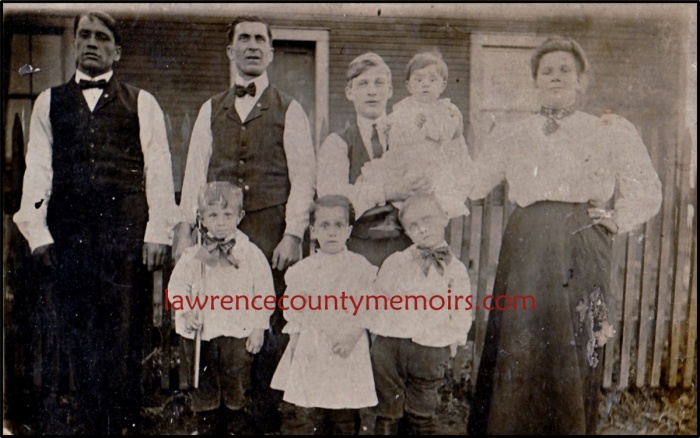 The LaPatka (originally LoPatka) family, Rusyn immigrants from the Hungarian Empire who became members of St. Nicholas, at their home on Plum Way/Katherine Street in Chewton. Maria “Mary” Brinczkova (1882-1952) emigrated to Chewton in 1899 to live with her half-brother Michael Burik. She soon relocated to Pittsburgh, met fellow Rusyn John LaPatka (1873-1949), and returned to Chewton to start a family. They had thirteen children that survived infancy and another three that died soon after birth. John and Mary were born and raised in modern-day Slovakia, along the River Torysky near the foot of the Carpathian Mountains. They grew up in neighboring Rusyn villages, Mary in Nizne Repase and John in Olsavica, but never met until years later in Pittsburgh. Back row from right, mother Mary Brinczkova LaPatka, unidentified relative holding child Mary LaPatka (Aiello), father John LaPatka, and John’s brother Mike. Front row from right are children Mike, Ann (Concilla), and George LaPatka. John and Mary, John’s brother Mike, and son George are buried in St. Nicholas Cemetery in Slippery Rock Township. (c1908) Full Size |
 My maternal great grandparents John and Mary (Brinczkova) LaPatka, immigrants from Austria-Hungary who settled in Chewton in 1901, and their children attended this Orthodox church for many years. The photo above depicts their daughter Irene LaPatka, on the day she married an Italian named George DeMarc of West Pittsburg. George & Irene (my grandparents) are standing in front, while their siblings Pauline LaPatka & Charles DeMarc Jr. (obscured) are in back. (Nov 16, 1946) Full Size |
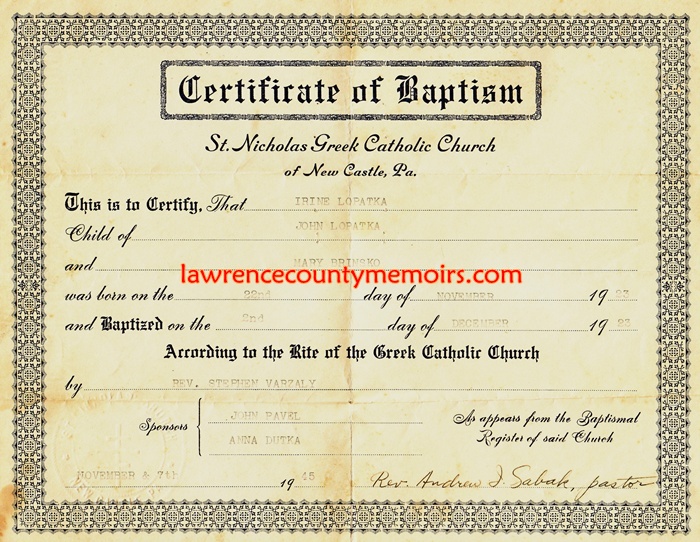 A copy of my maternal grandmother Irene LaPatka’s baptism certificate from St. Nicholas. (1945) Full Size |
 New Castle News Friday Oct 29, 2010 |
 (2011) |  (2011) |
 (2011) |  (2011) |
 (2011) |  (2011) |  (2011) |
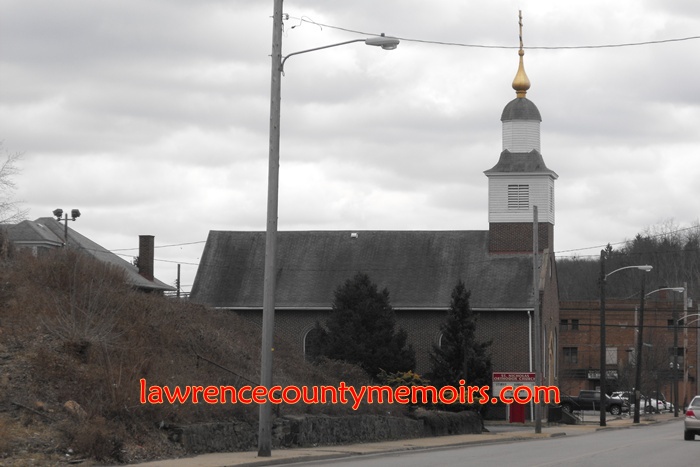 (Mar 2013) Full Size |




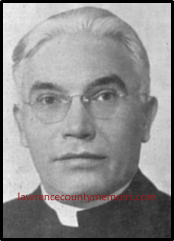
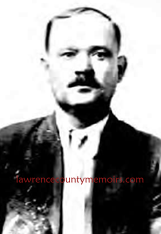
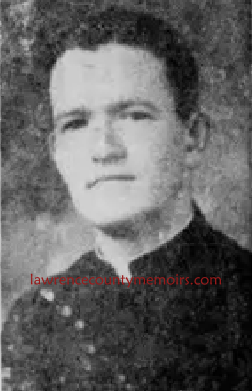
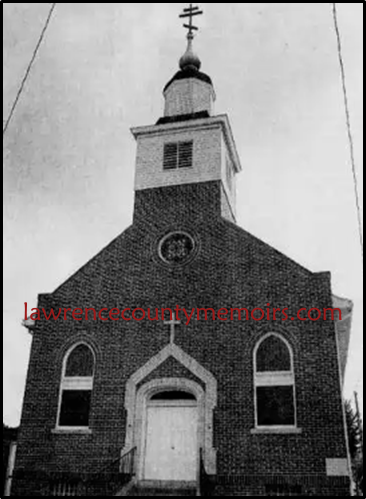
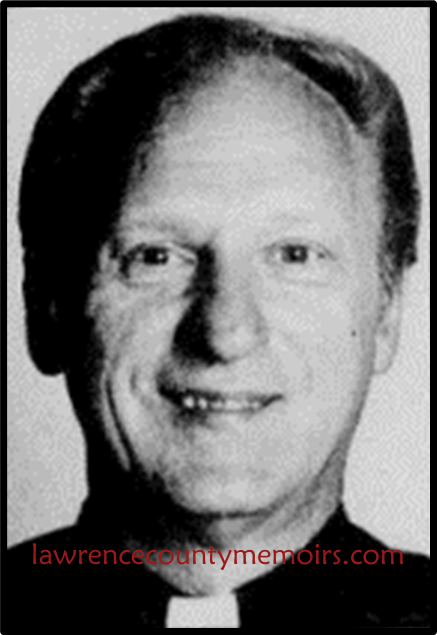
Comments
Richard Kovacs #
Thank you for this tremendous site. I was born in Jameson Hospital in 1951 and attended St. Nicholas with my parents George and Mary (Flyak) Kovacs and grandparents Peter and Susan (Duda) Kovacs and Michael and Martha (Lison) Flyak. Peter, who died in 1926, made the wooden knocker used in Good Friday services. My relatives are buried in the St. Nicholas Cemetery on Copper Road off of Route 422. Martha Lison was born and raised in Nizne Repase, Slovakia, and Michael Flyak lived nearby. There’s a great website (www.cisarik.com/cemetery-niznerepase.htm) that shows pictures of Nizne Repase including the cemetery with its rather elaborate markers for Lisons, Teplicas, and many others.
I moved to Cleveland with my parents and sister Marilyn in 1966 but remain interested in Lawrence County. We lived on Cascade Street across from Blair Strip Steel and as kids used to explore the old cement factory behind Blairs. I recently discovered from aerial views that there were two more cement factories north of County Line Road by the limestone quarries. I found out that Lehigh Cement bought them from their New Castle owners and abandoned them in the depression. I’d love to know more about these impressive structures and how cement was made there. Our house and neighboring houses were originally cement company houses – there were even cement curbs marking the boundaries. Memories, memories…
Jeff Bales Jr #
(EDITOR’S NOTE) Richard, Thanks so much for the post and the compliments. Small world. My maternal great grandmother Maria “Mary” (Brinczkova) LaPatka was also born in Nizne Repase back in 1882 and her future husband, Jan “John” LaPatka, was born nearby in Olsavica. They met in Pittsburgh and moved to Chewton. They attended St. Nicholas Church and were later buried in St. Nicholas Cemetery. In fact six relatives of mine from the LaPatka family are buried at the cemetery as well… I’ll try to find out more about the cement plants you mentioned. Thanks for taking the time to post your comments! Jeff
Rich Custer #
It’s evident that the church cornerstone visible in the wedding photo above is different from that on your color photo; presumably the wedding photo shows the original cornerstone. Any chance it can be made out more clearly from your original photo, perhaps scanned at higher resolution?
(I ask because I am working for over 20 years on a history of the Carpatho-Rusyn immigrant settlement of the entire state of Pennsylvania, and these little details are of great interest.)
Thanks!
Jeff Bales Jr. #
(EDITOR’S NOTE) Rich, It appears that your assumption is correct. A closer look at the old photo reveals what looks like five rows of text, vice the four in the newer photo. I know that according to the New Castle News within the original cornerstone was placed, “…a list of the priests present, newspapers, religious and other articles of value to future generations…” If it is a new cornerstone these days I suspect the old stone was removed and opened – perhaps during the 100th anniversary in September 2010. I’ll see what I can find out. Not sure I’ll be able to get a clearer view of the stone from the old photo but I’ll see what I can do. Thanks so much for your inquiry! Maybe we will solve this mystery yet. Jeff
Ed Lazor #
I am doing a lot of research on my gyneology. My father left SE Poland in the 1940’s and I believe I may be related to Stephen Varzaly. Historical records indicate that in 1921 Stephen Varzaly left Austria-Hungary to come to St. Nicholas Greek Catholic Church in New Castel, Pa. His wife and “six” children followed. Note that Stephen had seven children, not six. I am trying to figure out which child stayed behind in the Slovakia area. The seven children’s names were: Eugene Varzaly, Stepen Varzaly, George Varzaly, Adela Varzaly Matiak, Dolores Varzaly Amman, Martha Varzaly Gaydos and Maria Louisa Varzaly Lazor. I suspect it was Maria Lazor that stayed behind but I would love to confirm that with decendents of the Varzaly family. Regards, Ed Lazor
Andrew Sabak #
My father, Rev. Andrew I. Sabak, served the New Castle Church 1945-1949 as his first parish after ordination as seen above with his name on the baptismal records extract. However, neither he nor Father Varzaly and other priests who were very proud of being Carpatho-Russians (as seen on the cornerstone) would recognize the recent word “Rusyns”, which word did not exist back then. Father Varzaly was extremely pro-Russian, as were the bulk of our people from current-day Slovakia and Ukraine.
Doris Aguilar (Gorzo) #
I am doing gynecology search. My grandfather’s name is Julis Gorzo the son of Rev. Valentine Gorzo. I would like to know if he married his son and you could tell me when and if he did, how could I get a copy of the marriage license?
Eugene ( Gene ) Boratko #
My maternal grandparents came from Nizne Repase and went to St. Nicholas. They were Joseph and Maria Flack ( were original Flyak but the Ellis Island people Americanized their name ). They lived at 417 E. Reynolds St. My paternal grandparents were from Spisska Nova Ves ( Samuel and Maria Boratko ).
john schweich #
I amgiving a presentation to the Carpatho-Rusyn Society of Youngston on the C-R churches of Lawrence and Merer counties in PA and Mahoning and Trumbill counties of Ohio. I am seeking information on Holy Trinity Russian Orthodox Church of New Castle (founded in 1909).
DAVID #
HELP ! I would appreciate any information you might have on my patriarchal grandmothers roots from NIZNE REPASNE
Not sure if the spelling is correct but the surnames are BRINCKO, LISON/LESON, lAGONA/LAGANOVA.
Thanks
Richard Kovacs #
Wow, so many great posts.
1) Jeff, thank you for the kind words. I have seen the LaPatka family markers in the cemetery.
2) Rich Custer, thank you for working on a history of the Carpatho-Rusyn immigrants. I will be crediting your fine work in my family memoirs.
3) Ed, I had good luck accessing digital records (not the original handwritten documents) from Ancestry.com’s Family Search (Mormon LDS records) of baptisms in the Greek Catholic Church in Slovakia. The church placed a 100 year block on the original documents. Even though the ones I requested are older, there are still records on the same film roll within the 100 year period, so you cannot access any of them! But you can see the digital records that were typed into a computer by an archivist. It shows the names, dates, events, etc. For some reason my maternal grandmother’s digital record is missing and I asked them to check the film roll for it, but all of her siblings are there.
4) Andrew, you are correct that in our youth we were considered to be American Carpathian Russians and members of the Orthodox Christian Greek Catholic Church, usually stated, I believe, as St. Nicholas Russian Orthodox American Greek Catholic Church.
The term ‘Carpatho-Rusyn’ and its Latinized name ‘Ruthenian’ have early roots. Friends of mine whose family came from the same region in Slovakia as my grandparents insist that we are Ruthenian, not Russian. That sentiment evidently has spread.
The state of Kievan Rus’ was established in 882 CE by Varangians (Swedish Vikings) who invaded the area. Russia, which the Varangians settled in 862—the beginning of Russian history—is derived from ‘Rus’. Kievan Rus’ fell to the Mongol invasion of the 1240s. Area Slavic states became part of the Golden Horde Empire, parts of which lasted until 1480. One of the impacts of the Mongol invasion was the separation of Russia and Ukraine into separate countries.
Carpatho-Rusyns refused to adopt the name Ukrainian in the early 20th century. Poland and Czechoslovakia banned the term Rusyn in 1945, but today Slovakia, Ukraine, Poland, and Hungary officially recognize Rusyns as an ethnic minority. Evidently, our European relatives asked that they be called Rusyns.
A 1911 Austria Hungary map clearly shows a fairly broad area of present-day Slovakia that includes Nizne Repase as being Ruthenian, not Russian or Ukrainian. It’s believed that a state of Ruthenia did briefly exist.
Fr. Varzaly objected to the Holy See intending that new Greek Catholic priests no longer marry, and he held a preference for bringing St. Nicholas under the Patriarch of Constantinople (not under the Patriarch of Moscow).
5) Doris, all marriage records in Pennsylvania are kept by the counties (Marriage License Clerk in the County Courthouse).
http://www.portal.state.pa.us/portal/server.pt/community/vital_records/8736/pennsylvania_marriage_and_divorce_records/524158
New Castle is in Lawrence County. Call the Marriage License Clerk at (724) 658-2541. Or you may go to Ancestry.com and use their 2 week free access—you’ll need to give them a valid credit card number first in case you run over the free period. You can find the marriage records in their data base or in the Family Search (Mormons LDS) data base that Ancestry makes available.
6) Eugene, my Aunt Anne Flyak Chuba told me that Flyak is the Hungarian (Magyarized) spelling and that the true spelling was ‘Flak’. I’ve seen it spelled that way in Greek Catholic Church records from Slovakia, but I’ve also seen it as Flyak and Flack. (Although Slovakia was part of the Kingdom of Hungary for nearly 1,000 years, Magyarization came mostly after 1849 with the formation of the Austro-Hungarian Empire. I no longer have access to the church records, but a look back at names before 1849 may show its real spelling. They go back to the early 1600s, as I recall.)
7) David, my grandmother, Martha Lison (Marta Liszony in Hungarian, as Magyarized) was born in Nizne Repase, Slovakia in 1905. She died in Youngstown, Ohio in 1989. Her mother was Martha Kascak and her father was Peter Lison. Her siblings were all born in Nizne Repase, as follows: 1883-Joannes, 1886-Petrus, 1888-Maria, 1889-Catharina, 1894-Stephanus, 1895-Anna, 1898-Georgius.
Joannes (John) must have died young; Peter had two sons and four daughters; Mary Brincko had three sons and two daughters; Catherine Brincko had two sons and four daughters (Catherine Sopkovich, Julia Lamski, Margaret, and Mary Shields); Stephen must have died young; Anna Hnatt (an earlier Anna had died at birth) had two sons and four daughters; and George had one son and four girls. I have a photo of my grandmother and her two Youngstown sisters at the time of my mother’s wedding in 1948.
8) It’s genealogy, not gynecology!
Valerie Gaydos #
This is a reply to Ed Lazor. Father Varzaly was my maternal grandfather. In 1920 he emigrated to the United States on assignment to St. Nicholas Greek Catholic Church in New Castle, Pennsylvania. My grandmother was prepared to make the trip with him with two boys (Eugene, Stephen) but she discovered she was pregnant. After Adele (Adeline) was born in 1921 my grandmother and the three children who were born in Fulianka followed. Three more kids (George, Delores and Martha) were born in New Castle. The family moved in 1932 to the parish of Saint Michael’s Greek Catholic Church in Rankin, Pennsylvania where the 7th child, Maria Louisa (Mary Lou) was born. (She married Joe Lazor, nephew of Metropolitan Theodosis and brother of Very Rev. Paul Lazor who served as Dean of St Vladimir’s Orthodox Theological Seminary) Here is the link to the Wiki article on Father Varzaly: https://en.wikipedia.org/wiki/Stephen_Varzaly
Art Hazimanolis #
I am requesting to speak with Father Sally about my family situation.
He knows my family very well and I am in desperate need of his help.
He can call me at either 724-658-8365 or 724-498-2964.
Thank you very much,
Art
Barbara Jaruszewicz #
Hi Father Salley,
I was wondering if you could help me find family history on how Archbishop Nicholas T. Elko is related to my father….Andrew Baka. . My dad, mom, and brother are buried in St. Nicholas Cemetery.
My dad left me a cross with Christ and the skull and bones symbolizing Adam’s sins and I think rosewood on background. I’m interested in family. My dad and his parents were from Tubetown section of Mahoningtown. I married and live in Erie but faithfully visit the cemetery about four times a year.
Thank you for all of your service and dedication to the church and community.
Unfortunately, I don’t have much information. My grandparents were Andrew and Mary Kolesar Baka.
Linda Teplica #
My grandfather and his brothers came from Nizne Repase, which I visited on 2006. I still have 2nd cousins living there. My cousin Maria Teplicova of Nizne Repase has a best friend whose last name is Lisonova, the female version of Lison. Could be a distant relative of Martha Lison. I grew up in St. Nicholas church and remember the Flyaks and someone named Olga Lazor both names mentioned above.
Richard Kovacs #
The term Rusyn isn’t new; it applied to our ancestors since at least the mid-1800s. In America, Rusyns are often referred to as Carpatho-Rusyns to indicate where in Europe they come from. Europeans already know, so they simply say Rusyns. Ruthenian is a broader term which includes Lemkos, Hutsuls, Rusyns, and other Subcarpathian peoples.
The term Subcarpathia is often used by scholars to describe a portion of Transcarpathia that emcompasses Ruthenians, although technically it refers to the lowland areas west, north and east of the Carpathian Mountains. Our people were from the southern slopes, the lowlands of which make up the Pannonian (or Hungarian) Basin.
In a highly researched and detailed book titled “The Rusyns of Hungary” by Maria Mayer, the author describes the efforts in the latter half of the 19th century by Russians and Subcarpathian Russophiles to convert our Rusyn ancestors from their traditional Greek Catholic faith to Eastern Orthodoxy in a Pan-Slavic movement.
St. Nicholas Church was founded as a Greek Catholic church — not an orthodox church — by Rusyns in 1910. Greek Catholics had been in full communion with the Holy See of Rome since the Union of Uzhhorod in 1646, in which our priests were granted the right to marry and the Old Slavonic Liturgy and Cyrillic alphabet and other concessions were agreed to. Interestingly, it was the Jesuits who convinced the Holy See to grant these concessions in order to prevent wholesale conversion to the Eastern Orthodox faith.
Our poor ancestors tired of excessive demands placed on them by the Greek Catholic priests (to cook and clean for them and donate more money), so many converted to Eastern Orthodoxy, both before and after the turn of the previous century. The issues followed them to America. When Rome reneged on key provisions of the Union of Uzhhorod — new priests in America must be celebate, Liturgical Latinisation, among others — America’s Greek Catholic priests began looking to convert to Eastern Orthodoxy, too.
St. Nicholas eventually converted to Eastern Orthodoxy under ACROD. Rev. Varzaly supported ACROD, even serving as treasurer; but many years after leaving St. Nicholas, he became disenchanted with the Ecumenical Patriarchate of Constantinople (Eastern Orthodoxy), believing the Moscow Patriarchate (Russian Orthodoxy) would better serve our people. ACROD remained with Constantinople but St. Nicholas became Russian Orthodox in name.
Many Americans these days are unaware of Rusyn ethnic identification and say our people are Russian or Ukrainian. The unfortunate term Russian Orthodox somewhat masks our distinctly Rusyn identity. Russians have long been trying to pull together all the nationalities from the original Kievan Rus’ federation, including ethnic Rusyns. Equally concerning is that the Ukrainians say Rusyns are really Ukrainians. The various Subcarpathian ethnic groups experienced different governance and customs over many centuries. There’s a strong movement underway to recognize Rusyns as the distinct ethnic group they are, whether or not they reestablish a Ruthenian nation, as briefly existed at the end of World War I.
Comment